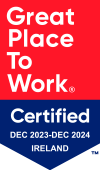Do you know your duties as an employer?
Have you identified and checked all potential hazards?
When was the last time you carried out a health and safety inspection?
In this Health and Safety 101, we run through some often overlooked workplace essentials. New business owners or those seeking to expand from small to medium-sized operations often struggle to meet required health and safety standards or comply with the latest regulations. Here’s a quick overview of what you need to know.
Safety is paramount in the workplace, therefore it is incumbent upon all employers, no matter the size of their operation, to develop sound policies and good workplace practices. Needless to say, specific industries, occupations, and hazards – construction, farming, manufacturing, pharmaceutical, and electrical – require more stringent H&S practices than others such as insurance or banking.
Whether you’re running a hair salon in West Cork or a large engineering firm in Athlone, you will need to adhere to regulatory health and safety guidelines. So, what exactly are your obligations as an employer and service provider?
Health and Safety – Employer Duties
As an employer, what are my duties under Health and Safety legislation?
Under the requirements of the latest Health and Safety legislation, all employers have duties of care to their employees, primarily to create and maintain a safe and healthy workplace. Employers in Ireland are obliged to:
- Conduct and manage all workplace activities in such a way as to ensure the health and safety of personnel
- Provide a clean, safe, and obstruction & risk-free workspace and place
- Carry out regular risk assessments to mitigate against risk and hazards including substances, noise, objects, etc.
- Plan and maintain risk-free systems of work
- Provide appropriate protective clothing and equipment to the agreed regulatory standard
- Provide and maintain clean and safe “welfare spaces” in the workplace such as rest areas, canteens, sick room(s), etc.
- Develop and provide regular health and safety awareness training
- Appoint a Health and Safety Officer, and/or if appropriate an Health and Safety or Ergonomics team
- Ensure the health and safety of all visiting parties, maintaining well-appointed meeting areas
- Maintaining an incident report log, to document details of all workplace incidents
- Acting on any risks identified resulting from incidents as they occur
The Five Steps to a Safer Workplace
Drafting a Safety Statement Under current legislation, Irish employers are bound in law to take all steps necessary to prevent workplace injuries and ill-health. This must include the drafting of a safety statement, the terms of which should be binding.
Basically, this safety statement is a detailed plan for safeguarding the health, safety, and welfare of all employees in the workplace – and that includes all workplaces, both onsite and at home. The safety statement should be drawn up only after a full risk assessment has been carried out.
What steps can I take to ensure a safe and healthy workplace?
Here is a comprehensive list of the steps can you take to manage health and safety?
- Identify Hazards & Risks
- Risk Assessment
- Decide on Control Measures
- Draft Safety Statement
- Manage & Maintain, Continuous Improvement
STEP 1
Identify Hazards & Risks
Employers need full awareness of all potential hazards and risks – anything with the ability to cause harm or injury – their employees might come up against in the workplace. Here is a quick checklist of typical workplace hazards:
- Slips, Trips, Falls – including falls of persons, materials, and equipment from a height
- Hazards – associated with manual handling of loads and mechanical handling
- Hazards – associated with plant and machinery
- Fire & Explosion
- Exposure to toxic substances
- Exposure to radiation
- Exposure to high levels of noise
- Movement of vehicles
- Unsuitable lighting, unmarked steps, loose paving
- Exposure to VDUs
- Deficient Thermal Environment – too hot, too cold
- Human Factors – careless or unsafe behaviour, bullying, etc.
STEP 2
Risk Assessment
Having identified the hazards and risks, it is now necessary to assess each in turn, giving more weight to those with the potential to cause the most damage, harm, or injury. High-risk hazards such as exposure to radiation should be prioritised over low-risk factors. However, it is important to remember that even low-risk factors can be extremely detrimental not just to employee welfare but to company finances. How many businesses have had personal injury cases taken against them for seemingly the most innocuous of falls?
Your risk assessment should address ALL significant hazards and risks, apply to ALL aspects and areas of the workplace, and consider both routine and non-routine operations.
STEP 3
Put Control Measures in Place
Once risks have been identified and assessed, suitable control measures must be put in place to minimise or eradicate risks. The goal here is to eliminate where possible or reduce the risk using a hierarchy of control eg.
- Could risk be avoided by eliminating certain work practices?
- If not, would adapting those work practices limit if not eliminate certain risks?
- Alternatively, would closing off certain areas help to minimise the potential for exposure to certain substances?
These control measures should follow the basic principles of risk prevention such as:
- Avoidance and evaluation of risk
- Careful and appropriate design, layout, and furnishing of workplace environs
- Adaptation of work environs to technical progress
- Safe storage and management of dangerous and/or harmful substances and equipment
- Prioritising collective protective measures
- Provision of adequate awareness training (on an ongoing basis)
STEP 4
Writing up a Safety Statement
Once the above actions have been completed, a Safety Statement should be drawn up. This would typically include,
- A list of control measures to be put in place to avoid the risk
- A list of names of those delegated with responsibility for ensuring those measures are carried out
- A detailed emergency response plan
The Safety Statement should be reviewed regularly and must be amended when there has been a significant change in work practices. It should be brought to the attention of all employees.
STEP 5
Manage & Maintain, Continuous Improvement
As said above, the Safety Statement must be constantly updated in line with operational or situation changes in the workplace, thereby ensuring continuous improvement in health and safety practices and the working environment. It should be reviewed at least once annually. In addition, outputs of all risk assessments and reviews, as well as details of incident reports should be documented and any remedial or recommended actions carried out or controls put in place.
A safe, clean, and healthy workspace and environment is the least any employer can offer their employee. Remember, many of us spend most of our waking hours in the workplace. Whether that be in the home office or on-site, work takes up a large portion of our time. If we’re not comfortable or confident in our surroundings, our concentration and morale will dip, negatively impacting our productivity.
A wonky chair can cause serious backache.
Loose threads on a carpet can result in a sprained ankle.
Dirty toilets can spread disease.
Faulty lighting can cause potentially harmful accidents.
For more information on Occupational Health and Safety best practices, talk to one of our consultants about ISO 45001. Find out how the leading ISO OH&S standard can help safeguard health and safety in your workplace.
Learn more about ISO 45001 and how certification can benefit your business
For more information on ISO 9001 Quality Management System, ISO certification, and ISO QMS services offered by CG Business Consulting contact Caroline at hello@cgbc.ie or 01 – 620 4121.





